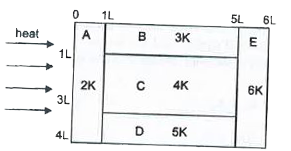Two slabs A and B, each though similar, in all other respects, have different materials. They are placed one above the other in perfect contact and a steady difference of temperature of 36∘C is maintained across the combination. If the thermal conductivity of A is twice that of B, what is the temperature of interface ? Solution in Kannada
16∘C
12∘C
28∘C
24∘C.
The correct Answer is:D
In steady state, rate of flow of heat is same
H1=H2.
k1AΔθ1d=k2AΔθ2d
Δθ1Δθ2=k2k1=12
Δθ2=2Δθ1.
Also Δθ1+Δθ2=36∘C
∴ 3Δθ1=36∘C
Δθ1=12∘C
⇒36−T=12⇒T=24∘C
Thus correct choice is (d).
Topper's Solved these Questions
- TRANSFERENCE OF HEAT BOOK - MODERN PUBLICATIONCHAPTER - TRANSFERENCE OF HEAT EXERCISE - Multiple Choice Questions (Level - III) Questions From AIEEE/JEE Examination)
5 Videos
- TRANSFERENCE OF HEAT BOOK - MODERN PUBLICATIONCHAPTER - TRANSFERENCE OF HEAT EXERCISE - Recent Competitive Questions
4 Videos
- TRANSFERENCE OF HEAT BOOK - MODERN PUBLICATIONCHAPTER - TRANSFERENCE OF HEAT EXERCISE - Recent Competitive Questions
4 Videos
- SOLIDS & SEMICONDUCTOR DEVICESBOOK - MODERN PUBLICATIONCHAPTER - SOLIDS & SEMICONDUCTOR DEVICESEXERCISE - Revision Test
28 Videos
- UNIFORM CIRCULAR MOTIONBOOK - MODERN PUBLICATIONCHAPTER - UNIFORM CIRCULAR MOTIONEXERCISE - Revision Test
57 Videos
Similar Questions
A composite block is made of slabs A,B,C,D and E of different thermal conductivities (given in terms of a constant K) and sizes (given in terms of length, L) as shown in the figure. All slabs are of same width. Heat 'Q' flows only from left to right through the blocks.
Then in steady state

View SolutionTwo slabs are of the thicknesses d1 and d2. Their thermal conductivities are K1 and K2 respectively They are in series. The free ends of the combination of these two slabs are kept at temperatures θ1 and θ2. Assume θ1>θ2. The temperature θ of their common junction is
View SolutionTwo slabs are of the thicknesses d1 and d2. Their thermal conductivities are K1 and K2 respectively They are in series. The free ends of the combination of these two slabs are kept at temperatures θ1 and θ2. Assume θ1>θ2. The temperature θ of their common junction is
View SolutionChoose the forward biased p-n junction :
View SolutionA sphere of mass m is tied to end of a string of length 1 and rotated through the other and along a horizontal circular path with speed . The work done in full horizontal circle is:
View SolutionThe temperature across two different slabs A and B are shown I the steady state (as shown Fig) The ratio of thermal conductivities of A and B is
View SolutionTwo slabs A and B of equal surface area are placed one over the other such that their surfaces are completely in contact The thickness and coefficient of thermal conductivities of slab A is twice that B The first surface of slab A is maintained at 100∘C while the second surface of slab B is maintained at 25∘C The temperature at the contact of their surfaces is .
View SolutionA partition wall has two layers of different materials A and B in contact with each other. They have the same thickness but the thermal conductivity of layer A is twice that of layer B. At steady state the temperature difference across the layer B is 50 K, then the corresponding difference across the layer A is
View SolutionTwo slabs A and B of equal surface area are placed one over the other such that their surfaces are completely in contact. The thickness of slab A is twice that of B. The coefficient of thermal conductivity of slab B is maintained at 25∘C. The temperature at the contact of their surface is
View SolutionTwo slabs A and B of different materials but of the same thickness are joined end to end to form a composite slab. The thermal conductivities of A and B are K1 and K2 respectively. A steady temperature difference of 12∘C is maintained across the composite slab. If K1=K22, the temperature difference across slab A is
View SolutionTwo slabs A and B of different materials but of the same thickness are joined end to end to form a composite slab . The thermal conductivities of A and B are K1 and K2 respectively . A steady temperature difference of 12∘C is maintained across the composite slab . If K1=K22 , the temperature difference across slab A is
View SolutionTwo slabs A and B of equal surface area are placed one over the other such that their surface are completely in contact. The thickness of slab A is twice that of B. The coefficient of thermal conductivity of slab A is twice that of B. The first surface of slab a is maintained at 100∘C, while the second surface of slab B is maintained at 25∘C. The temperature at the contact of their surface is
View SolutionA composite slab consists of two slabs A and B of different materials but of the same thickness placed one on top of the other. The thermal conductivities of A and B are k_(1) and K_(2) respectively. A steady temperature difference of 12^(@)C is maintained across the composite slab. If k_(1) = K_(2)//2 , the temperature difference across slab A will be:
View SolutionTwo slabs A and B, each though similar, in all other respects, have different materials. They are placed one above the other in perfect contact and a steady difference of temperature of 36∘C is maintained across the combination. If the thermal conductivity of A is twice that of B, what is the temperature of interface ?
View SolutionA wall has two layers A and B, each made of different material. Both the layers have the same thickness. The thermal conductivity of the material of A is twice that of B . Under thermal equilibrium, the temperature difference across the wall is 36∘C. The temperature difference across the layer A is
View Solution
